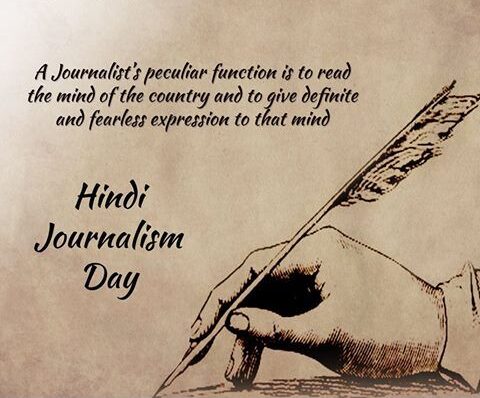🗞️ Hindi Journalism Day: A Celebration of Courageous Voices and Cultural Integrity
Hindi Journalism Day or Hindi Patrakarita Diwas is a momentous occasion celebrated across India on May 30th every year. It commemorates the publication of the first Hindi newspaper “Udant Martand” (The Rising Sun) in 1826—a groundbreaking moment that ushered in a new era of communication for the masses in their own language.
- 🕰️ History of Hindi Journalism Day
- 📅 Timeline of Hindi Journalism in India
- 🌟 7 Remarkable Facts About Hindi Journalism
- 🧠 FAQs on Hindi Journalism Day
- ❓ Why is Hindi Journalism Day celebrated on May 30?
- ❓ Who started Hindi journalism in India?
- ❓ What was the role of Hindi journalism in the freedom struggle?
- ❓ How relevant is Hindi journalism today?
- 🎉 Observance of Hindi Journalism Day
- 💌 Wishing Messages for Hindi Journalism Day
- 🎯 Importance in Our Life and Society
- ✅ 1. Access to Local News
- ✅ 2. Promotion of Regional Identity
- ✅ 3. Democratization of Information
- ✅ 4. Empowering Rural Voices
- ✅ 5. Combating Fake News
- 📝 Impact on Daily Life
- 🧭 Significant Points to Remember
- 📚 Role in Education and Ethics
- 🧭 Why It Matters to Celebrate Hindi Journalism Day
- 💬 Language is power.
- 🗣️ Journalism is not just a profession—it’s a public service.
- 🏆 From Udant Martand to Dainik Jagran…
- ✍️ Conclusion: Hindi Journalism—A Voice That Will Never Be Silenced
But Hindi Journalism Day isn’t just a tribute to a newspaper—it’s a symbol of free speech, grassroots empowerment, and the power of local language journalism in shaping India’s democracy and awareness.
🕰️ History of Hindi Journalism Day
The roots of Hindi journalism trace back to May 30, 1826, when Pandit Jugal Kishore Shukla, a visionary from Kanpur, published the first Hindi-language newspaper, “Udant Martand,” from Kolkata (then Calcutta).
Though the paper only survived for about a year and a half, its impact on Indian media and Hindi language journalism was immense. It gave voice to millions of Hindi speakers during a time when most newspapers were in English or Bengali—languages not accessible to the majority of Indians.
This day is now commemorated as Hindi Journalism Day to honor that courageous leap into vernacular journalism and its lasting legacy.
📅 Timeline of Hindi Journalism in India
| Year | Event |
|---|---|
| 1826 | “Udant Martand” published—the first Hindi newspaper |
| 1850–1900 | Rise of nationalist newspapers like Bharat Mitra, Kavi Vachan Sudha |
| 1920s–1947 | Hindi journalism played a key role in India’s independence movement |
| Post-1947 | Growth of major Hindi dailies like Dainik Jagran, Navbharat Times, Amar Ujala |
| 2000s | Digital journalism emerges in Hindi, empowering rural and urban readership alike |
| Present | Hindi is one of the most widely read news languages in India |
🌟 7 Remarkable Facts About Hindi Journalism
Udant Martand was handwritten in Devanagari script and published weekly on Tuesdays.
Despite being short-lived, the paper is considered the torchbearer of Hindi media.
The first editor, Jugal Kishore Shukla, had limited resources and faced financial hardships.
Hindi journalism helped mobilize masses during the freedom struggle by making information accessible.
Today, Hindi newspapers like Dainik Bhaskar and Dainik Jagran rank among the largest circulated dailies in the world.
Hindi journalism gave rise to many revolutionary poets and freedom writers like Ganesh Shankar Vidyarthi.
With the rise of digital platforms, Hindi journalism is expanding globally, reaching diaspora communities.
🧠 FAQs on Hindi Journalism Day
❓ Why is Hindi Journalism Day celebrated on May 30?
It commemorates the publication of India’s first Hindi newspaper, Udant Martand, on May 30, 1826, in Kolkata.
❓ Who started Hindi journalism in India?
Pandit Jugal Kishore Shukla is considered the father of Hindi journalism for founding Udant Martand.
❓ What was the role of Hindi journalism in the freedom struggle?
Hindi newspapers provided a platform for nationalist voices and helped in spreading awareness and patriotic sentiments among the common people.
❓ How relevant is Hindi journalism today?
In the era of regional content dominance, Hindi journalism continues to influence public opinion, especially in Hindi-speaking states and rural regions.
🎉 Observance of Hindi Journalism Day
Journalism institutions organize debates, workshops, and essay competitions.
Media houses remember historical contributions and honor veteran journalists.
Universities conduct special seminars on media ethics, evolution, and Hindi literature.
State governments and journalism associations issue awards recognizing impactful Hindi journalism.
Social media campaigns using hashtags like #HindiJournalismDay and #UdantMartand go viral.
It’s a day of gratitude, reflection, and rededication to the ideals of truth, clarity, and accessibility.
💌 Wishing Messages for Hindi Journalism Day
📰 “Saluting the courage and commitment of every Hindi journalist on Hindi Journalism Day! Your words shape our nation.”
🖋️ “Happy Hindi Journalism Day to those who speak truth in the language of the people.”
🇮🇳 “Let us celebrate the pioneers of Hindi journalism who dared to give the common man a voice. Jai Hindi Patrakarita!”
💡 “May the spirit of Udant Martand keep inspiring every pen that serves society. Happy Hindi Journalism Day!”
🎯 Importance in Our Life and Society
✅ 1. Access to Local News
Hindi journalism ensures that millions of non-English readers can stay informed about government policies, healthcare, employment, and more.
✅ 2. Promotion of Regional Identity
It helps preserve and promote Hindi language and culture, especially in the face of globalization.
✅ 3. Democratization of Information
Whether it’s a farmer in Bihar or a teacher in Uttar Pradesh, Hindi newspapers and digital platforms give everyone equal access to information.
✅ 4. Empowering Rural Voices
Rural issues—often neglected by mainstream English media—get priority coverage in Hindi journalism.
✅ 5. Combating Fake News
Trusted Hindi news outlets play a key role in countering misinformation, especially on WhatsApp and social media.
📝 Impact on Daily Life
In rural India, Hindi newspapers are still the morning staple, providing everything from news to job alerts.
Students preparing for competitive exams rely on Hindi dailies for current affairs.
Women and senior citizens, who might be less digitally inclined, often prefer reading in Hindi.
Hindi TV news channels like Aaj Tak and ABP keep the masses updated in real-time.
Hindi journalism has bridged the literacy gap, enabling people from all walks of life to participate in national dialogue.
🧭 Significant Points to Remember
Hindi Journalism Day = May 30
First newspaper = Udant Martand
Founder = Pandit Jugal Kishore Shukla
Place of Publication = Kolkata
Started in = 1826
Role: Empowerment of Indian masses through regional journalism
📚 Role in Education and Ethics
Journalism schools teach Hindi editorial writing, media law, ethics, and reporting as core subjects.
Hindi journalists are often grassroots storytellers, covering marginalized communities, local governance, and citizen rights.
Their work reflects societal truth through cultural lens—making them a pillar of India’s democracy.
🧭 Why It Matters to Celebrate Hindi Journalism Day
💬 Language is power.
When people are informed in their mother tongue, they become active citizens. Hindi journalism made that possible.
🗣️ Journalism is not just a profession—it’s a public service.
And those who do it in Hindi serve millions who would otherwise be unheard.
🏆 From Udant Martand to Dainik Jagran…
The journey tells a story of struggle, resistance, courage, and service to the people.
✍️ Conclusion: Hindi Journalism—A Voice That Will Never Be Silenced
Hindi Journalism Day is more than a date on the calendar. It’s a celebration of India’s linguistic pride, democratic spirit, and journalistic integrity. From pre-independence revolutionaries to today’s rural reporters, Hindi journalism has always stood by the common man—informing, empowering, and inspiring.
As we celebrate the legacy of Pandit Jugal Kishore Shukla and his Udant Martand, let’s also pledge to uphold truthful reporting, embrace linguistic diversity, and continue supporting journalism that speaks the language of the people.
Happy Hindi Journalism Day!
Let truth shine in every script, and let every voice be heard. 🙏🗞️








